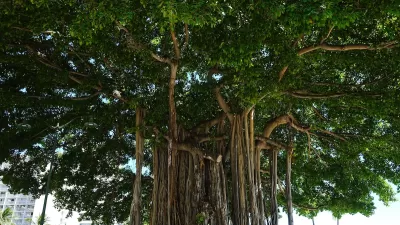The U.S. Forest Service has continued to refine the valuable i-Tree software program, which allows cities to calculate the benefits, in dollar figures, of the urban forest.

Laura Bliss reports on the work of David Nowak, a lead researcher at the U.S. Forest Service’s Northern Research Station in Syracuse, New York, and one of the founding developers of the Forest Service's i-Tree software programs.
The i-Tree system uses GIS and a complex set of algorithms, to provide "detailed inventories of their urban canopies, and calculate their dollar value." Bliss details how the i-Tree program worked for a study of Austin's urban forest in 2014 [pdf]:
A recent i-Tree analysis of Austin, Texas, led by Nowak, estimated that trees save that city nearly $19 million annually in reduced building-energy use, some $5 million in reduced carbon emissions, and account for about $16 billion as standalone physical assets. Past that, they’re worth $3 million per year in their reduction of air pollution (based on avoided respiratory health problems), and nearly $12 million per year in the amount of carbon they sequester.
The i-Tree system has been collecting new metrics since it was first released in 2006, but Nowak is still working to add more ways to quantify the benefits of trees. "Right now, some of Nowak’s work is focused on calculating the dollar value of the reduced air temperatures and absorbed UV radiation that trees provide," according to Bliss.
The article includes more about the additional potential for the i-Tree program, as well as additional findings the program has revealed about urban forests around the country.
FULL STORY: What Are Trees Worth to Cities?

Alabama: Trump Terminates Settlements for Black Communities Harmed By Raw Sewage
Trump deemed the landmark civil rights agreement “illegal DEI and environmental justice policy.”

Planetizen Federal Action Tracker
A weekly monitor of how Trump’s orders and actions are impacting planners and planning in America.

The 120 Year Old Tiny Home Villages That Sheltered San Francisco’s Earthquake Refugees
More than a century ago, San Francisco mobilized to house thousands of residents displaced by the 1906 earthquake. Could their strategy offer a model for the present?

In Both Crashes and Crime, Public Transportation is Far Safer than Driving
Contrary to popular assumptions, public transportation has far lower crash and crime rates than automobile travel. For safer communities, improve and encourage transit travel.

Report: Zoning Reforms Should Complement Nashville’s Ambitious Transit Plan
Without reform, restrictive zoning codes will limit the impact of the city’s planned transit expansion and could exclude some of the residents who depend on transit the most.

Judge Orders Release of Frozen IRA, IIJA Funding
The decision is a victory for environmental groups who charged that freezing funds for critical infrastructure and disaster response programs caused “real and irreparable harm” to communities.
Urban Design for Planners 1: Software Tools
This six-course series explores essential urban design concepts using open source software and equips planners with the tools they need to participate fully in the urban design process.
Planning for Universal Design
Learn the tools for implementing Universal Design in planning regulations.
Clanton & Associates, Inc.
Jessamine County Fiscal Court
Institute for Housing and Urban Development Studies (IHS)
City of Grandview
Harvard GSD Executive Education
Toledo-Lucas County Plan Commissions
Salt Lake City
NYU Wagner Graduate School of Public Service





























